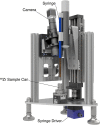Production of zirconium-88 via proton irradiation of metallic yttrium and preparation of target for neutron transmission measurements at DICER
- PMID: 36720963
- PMCID: PMC9889377
- DOI: 10.1038/s41598-023-27993-7
Production of zirconium-88 via proton irradiation of metallic yttrium and preparation of target for neutron transmission measurements at DICER
Abstract
A process for the production of tens to hundreds of GBq amounts of zirconium-88 (88Zr) using proton beams on yttrium was developed. For this purpose, yttrium metal targets (≈20 g) were irradiated in a ~16 to 34 MeV proton beam at a beam current of 100-200 µA at the Los Alamos Isotope Production Facility (IPF). The 88Zr radionuclide was produced and separated from the yttrium targets using hydroxamate resin with an elution yield of 94(5)% (1σ). Liquid DCl solution in D2O was selected as a suitable 88Zr sample matrix due to the high neutron transmission of deuterium compared to hydrogen and an even distribution of 88Zr in the sample matrix. The separated 88Zr was dissolved in DCl and 8 µL of the obtained solution was transferred to a tungsten sample can with a 1.2 mm diameter hole using a syringe and automated filling station inside a hot cell. Neutron transmission of the obtained 88Zr sample was measured at the Device for Indirect Capture Experiments on Radionuclides (DICER).
© 2023. The Author(s).
Conflict of interest statement
The authors declare no competing interests.
Figures







References
-
- Marquez-Nostra, B. V. & Viola, N. Radiopharmaceutical Chemistry (eds. Lewis, J.S., Windhorst, A.D. & Zeglis, B.M.). 371–390 (Springer, 2019).
-
- Decay Data Evaluation Project (DDEP), Laboratoire National Henri Becquerel, France. http://www.lnhb.fr/Laraweb/ (2022).
-
- Meijs WE, et al. Zirconium-labeled monoclonal antibodies and their distribution in tumor-bearing nude mice. J. Nucl. Med. 1997;38:112. - PubMed
Grants and funding
LinkOut - more resources
Full Text Sources

